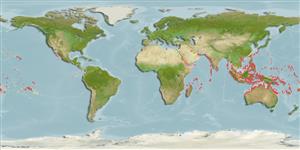>
Anguilliformes (Eels and morays) >
Muraenidae (Moray eels) > Muraeninae
Etymology: Echidna: Greek, echidna = viper, 1847 (Ref. 45335).
Eponymy: In Greek mythology Echidna was a female monster, and mother of many other monsters including the Hydra. Hesiod described her as “half a nymph with glancing eyes and fair cheeks, and half again a huge snake, great and awful, with speckled skin.” (Ref. 128868), visit book page.
More on author: Richardson.
Environment: milieu / climate zone / depth range / distribution range
экология
морской ассоциированный с рифами; пределы глубины 0 - 20 m (Ref. 90102). Tropical; 30°N - 24°S
Indo-Pacific: Red Sea and East Africa (Ref. 33390) to the Hawaiian, Marquesan, and Tuamoto islands, north to the Ryukyu Islands, south to the Great Barrier Reef.
Size / Вес / Возраст
Maturity: Lm ? range ? - ? cm
Max length : 72.3 cm TL самец/пол неопределен; (Ref. 90102)
колючие лучи спинного плавника (общее число) : 0; членистые (мягкие) лучи спинного плавника (общее число) : 0; колючие лучи анального плавника: 0; членистые (мягкие) лучи анального плавника: 0; позвонки: 132 - 137. Body grey with fine pale barring (Ref. 48635). Young with 25-30 dark brown bars separated by white narrow interspaces; bars become obscure with age where in large adults, the pattern becomes mottled brown; corner of mouth dark brown. Head usually lighter, yellowish with variable dark blotching (Ref. 48635).
Inhabits reef flats, clear shallow lagoons, and seaward reefs (Ref. 9710). Benthic (Ref. 58302). Feeds mainly on small crustaceans during both day and night (Ref. 9710). Minimum depth reported taken from Ref. 86942.
Life cycle and mating behavior
половая зрелость | размножение | нерест | икра | Fecundity | личинки
Chen, H.-M., K.-T. Shao and C.T. Chen, 1994. A review of the muraenid eels (Family Muraenidae) from Taiwan with descriptions of twelve new records. Zool. Stud. 33(1):44-64. (Ref. 6934)
Статус Красного Списка МСОП (Ref. 130435: Version 2024-2)
Угроза для людей
Harmless
Использование человеком
рыболовство: рыболовство как средство для существования; аквариум: коммерческий
дополнительная информация
инструменты
Специальные отчеты
Скачать в формате XML
ресурсы в Интернет
Estimates based on models
Preferred temperature (Ref.
123201): 25.2 - 29.3, mean 28.4 °C (based on 2833 cells).
Phylogenetic diversity index (Ref.
82804): PD
50 = 0.5005 [Uniqueness, from 0.5 = low to 2.0 = high].
Bayesian length-weight: a=0.00050 (0.00032 - 0.00078), b=3.31 (3.19 - 3.43), in cm total length, based on LWR estimates for this species & (Sub)family-body (Ref.
93245).
Trophic level (Ref.
69278): 3.5 ±0.4 se; based on diet studies.
устойчивость к внешним воздействиям (Ref.
120179): средний (среднего размера), минимальное время удвоения популяции 1.4-4.4 года (Preliminary K or Fecundity.).
Fishing Vulnerability (Ref.
59153): Moderate to high vulnerability (49 of 100).
Nutrients (Ref.
124155): Calcium = 37.3 [20.3, 61.5] mg/100g; Iron = 0.477 [0.288, 0.961] mg/100g; Protein = 18.6 [16.4, 21.2] %; Omega3 = 0.0945 [, ] g/100g; Selenium = 35.2 [19.9, 70.5] μg/100g; VitaminA = 65.2 [18.1, 200.0] μg/100g; Zinc = 1.08 [0.77, 1.49] mg/100g (wet weight);
